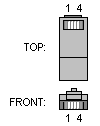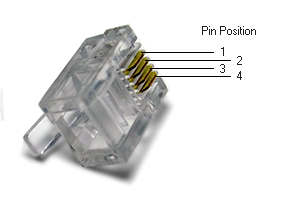Difference between revisions of "RJ11 connections"
m |
(No difference)
|
Latest revision as of 13:07, 6 June 2010
Female Male
RJ11 Telephone handset connections also used for some PC Keyboards (MAC)
A standard specifies both a physical connector and how it is wired. Sometimes the same connector is used by different countries but wired in different ways.
For example, telephone cables in the UK typically have a BS 6312 (UK standard) plug at the wall end and a 6P4C or 6P2C modular connector at the telephone end: this latter may be wired as per the RJ11 standard (with pins 3 and 4), or it may be wired with pins 2 and 5, as a straight through cable from the BT plug (which uses pins 2 and 5 for the line, unlike RJ11, which uses pins 3 and 4). Thus cables are not in general compatible between different phones, as the phone base may have a socket with pins 2 and 5 (requiring a straight through cable), or have an RJ11 socket (requiring a crossover cable). When modular connectors are used, the "latch release" of the connector should be on the "ridge" side of flat phone wire in order to maintain polarity.
Essentially all one, two, and three line analog telephones made today (2009) are meant to plug into RJ11, RJ14, or RJ25 jacks, respectively. RJ14 is similar, but for two lines, and RJ25 is for three lines. RJ61 is a similar registered jack for four lines. The telephone line cord and its plug are more often a true RJ11 with only two conductors.


